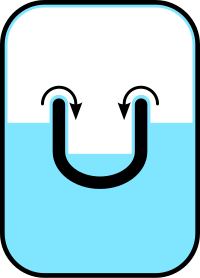
Photo from wikipedia
The paper investigates the coexistence and interplay of spin and mass superfluidity in a ferromagnetic spin-1 Bose-Einstein condensate. Superfluidity is possible only in the presence of uniaxial anisotropy (linear and… Click to show full abstract
The paper investigates the coexistence and interplay of spin and mass superfluidity in a ferromagnetic spin-1 Bose-Einstein condensate. Superfluidity is possible only in the presence of uniaxial anisotropy (linear and quadratic Zeeman effect). This follows from the topology of the order-parameter space (vacuum manifold). According to the Landau criterion, the critical phase gradients, both for mass and spin supercurrents, vanish at the phase transition from the easy-plane to the easy-axis anisotropy. However, mass superfluidity is still possible at the phase transition. This is because the Landau criterion signals instability only with respect to nonsingular vortices with special ratio between circulations of mass and spin currents. Phase slips produced by these vortices are not sufficient for complete decay of supercurrents. Full decay of supercurrents requires phase slips with vortices of another topological class and larger energy. These phase slips are suppressed by energetic barriers up to the upper critical velocity (gradient) exceeding the Landau critical velocity. The upper critical velocity does not vanish nor has any anomaly in the critical point at the phase transition from the easy-plane to the easy-axis anisotropy.
Journal Title: Physical Review B
Year Published: 2018
Link to full text (if available)
Share on Social Media: Sign Up to like & get
recommendations!